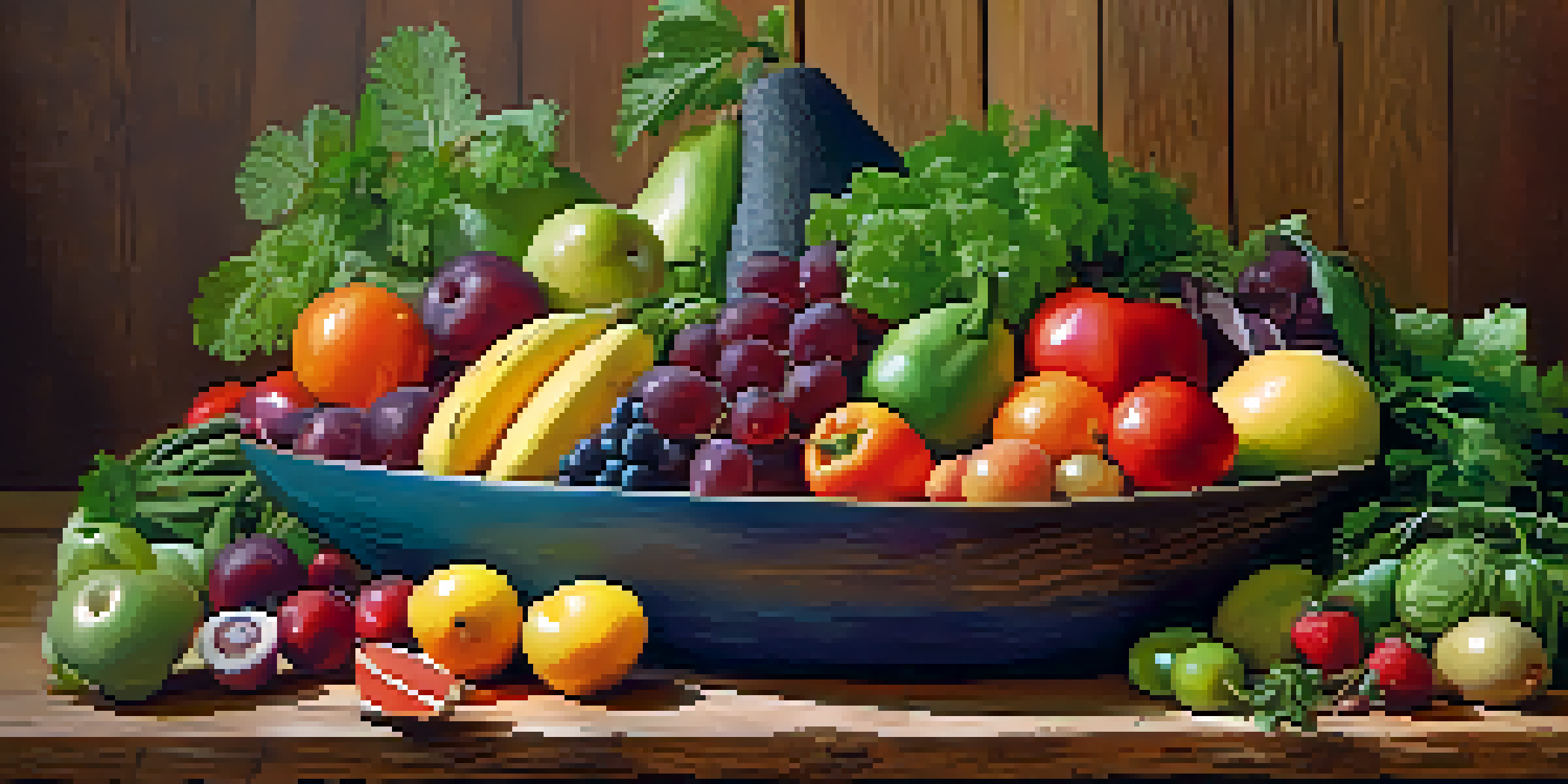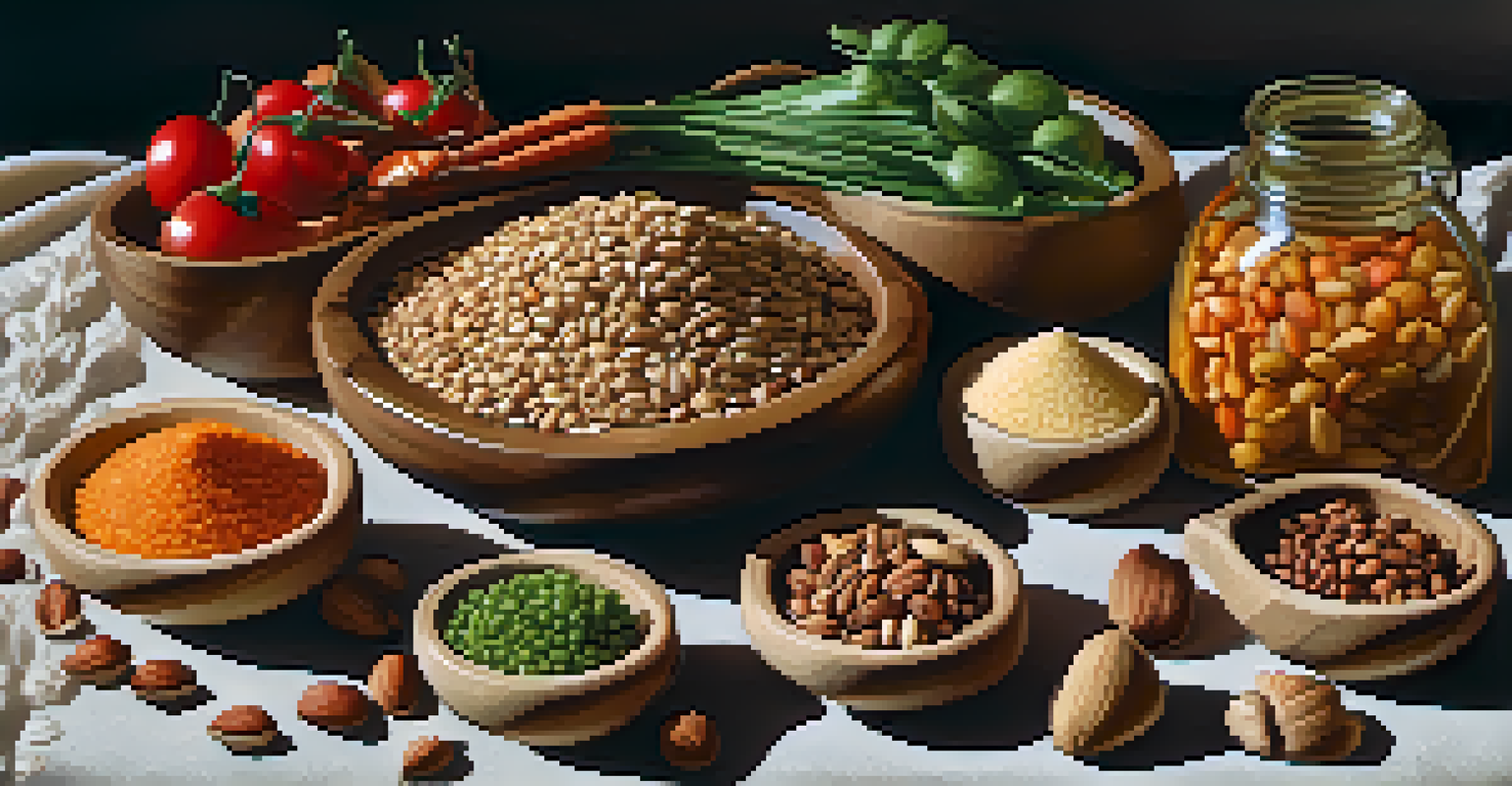Understanding the Principles of Raw Food Vegetarianism

What is Raw Food Vegetarianism?
Raw food vegetarianism is a lifestyle that emphasizes consuming unprocessed and uncooked plant-based foods. This means enjoying fruits, vegetables, nuts, seeds, and sprouted grains, all in their natural state. The philosophy behind this diet is that cooking can destroy essential nutrients and enzymes that are beneficial to our health.
Let food be thy medicine and medicine be thy food.
Imagine biting into a fresh apple or a handful of crunchy carrots; the vibrant flavors and textures are all part of the appeal. The raw food movement believes that these unaltered foods provide the maximum nutritional value and energy. Additionally, it aligns with a philosophy of minimalism and sustainability, encouraging a closer connection with nature.
As with any diet, understanding the principles is crucial for maintaining balance and health. Raw food vegetarianism can be a delicious and fulfilling way to eat, but it requires thoughtful planning to ensure you’re getting all the nutrients your body needs.
Key Principles of Raw Food Vegetarianism
At its core, raw food vegetarianism revolves around a few key principles: freshness, simplicity, and variety. Freshness is paramount; consuming foods in their raw state ensures that they retain their natural enzymes and nutrients. Simplicity encourages meals made from whole, unrefined ingredients, reducing processed foods to a minimum.

Variety plays a vital role as well; incorporating a wide range of fruits, vegetables, nuts, and seeds helps ensure that you get a balanced intake of vitamins and minerals. Think of it like painting a canvas: the more colors you use, the more vibrant and appealing the picture becomes. This variety not only enhances nutrition but also keeps your meals exciting and enjoyable.
Embrace Fresh, Whole Foods
Raw food vegetarianism emphasizes consuming unprocessed and uncooked plant-based foods for optimal health.
Following these principles can lead to a more mindful way of eating. By choosing fresh, simple, and varied foods, you can cultivate a deeper appreciation for the ingredients and their origins, fostering a healthier relationship with food.
Health Benefits of Raw Food Vegetarianism
One of the most discussed benefits of raw food vegetarianism is its potential to improve overall health. Many adherents report increased energy levels, better digestion, and clearer skin. This is often attributed to the high intake of fruits and vegetables, which are packed with vitamins, minerals, and antioxidants that support bodily functions.
The food you eat can either be the safest and most powerful form of medicine or the slowest form of poison.
For example, raw foods are typically low in calories but high in fiber, helping to promote satiety and aid in weight management. Imagine feeling satisfied after a meal without the heaviness that often accompanies processed foods. This can lead to healthier eating habits and a more balanced lifestyle.
Moreover, many raw food enthusiasts believe that this diet can reduce the risk of chronic diseases, such as heart disease and diabetes. By prioritizing whole, unprocessed foods, you may lower your intake of unhealthy fats and sugars, paving the way for better long-term health.
Incorporating Raw Foods into Your Diet
If you're intrigued by raw food vegetarianism, starting small can make the transition smoother. Begin by incorporating more raw fruits and vegetables into your daily meals. For instance, swapping a cooked vegetable side for a fresh salad can be an easy first step toward embracing this lifestyle.
Another approach is to prepare simple raw dishes, like smoothies or energy balls made from nuts and dried fruits. These not only taste great but also provide a convenient and nutritious snack. Think of it as adding color to your plate; the more raw foods you include, the more vibrant and appealing your meals will be.
Health Benefits Galore
This lifestyle can lead to increased energy, better digestion, and a reduced risk of chronic diseases.
As you become more comfortable with raw foods, you can experiment with recipes that involve techniques like soaking or sprouting. These methods can enhance the nutritional profile of grains and legumes, further expanding your culinary repertoire and making raw food vegetarianism a more enjoyable journey.
Common Misconceptions About Raw Food Diets
Like any dietary lifestyle, raw food vegetarianism comes with its own set of misconceptions. One common myth is that it’s overly restrictive or bland. In reality, the variety of flavors and textures available in raw foods can create exciting and satisfying meals. Imagine a colorful raw vegetable platter with hummus or a zesty fruit salad; these dishes are anything but boring!
Another misconception is that raw food diets lack sufficient protein. While it’s true that some raw foodists may need to be mindful of their protein sources, there are plenty of options available, such as nuts, seeds, and sprouted legumes. These foods can provide ample protein while still aligning with raw food principles.
It's also essential to note that raw food vegetarianism is not a one-size-fits-all approach. Everyone's nutritional needs and preferences are different, and it's crucial to find what works best for you while still enjoying the benefits of raw foods.
Potential Challenges of Raw Food Vegetarianism
While raw food vegetarianism offers numerous benefits, it’s not without its challenges. One significant hurdle can be the availability of fresh produce, especially in off-seasons or remote areas. Ensuring a steady supply of high-quality fruits and vegetables may require extra planning and effort.
Another challenge is the time commitment involved in preparing raw meals. Unlike grabbing a quick snack from a box, raw food preparation often involves washing, chopping, and sometimes soaking ingredients. However, with practice, meal prep can be streamlined, making it easier to maintain this lifestyle.
Overcome Common Challenges
While there are hurdles like meal prep and ingredient availability, small steps can make incorporating raw foods easier.
Lastly, social situations may pose difficulties for those following a raw food vegetarian diet. Dining out or attending gatherings can sometimes lead to limited options. However, bringing your own raw dish to share can be a fun way to introduce friends and family to the delicious world of raw foods.
Conclusion: Embracing Raw Food Vegetarianism
In conclusion, raw food vegetarianism offers an engaging and health-conscious way to embrace a plant-based lifestyle. By focusing on fresh, whole foods, this approach can lead to numerous health benefits and a deeper connection to the food we consume. It's about more than just eating; it’s a journey of exploration and rediscovery of flavors and nutrition.
As you consider integrating raw foods into your diet, remember that every small step counts. Whether you choose to go fully raw or simply add more raw meals to your week, every effort contributes to a healthier lifestyle. Think of it as a garden; the more you nurture it, the more it flourishes.

Ultimately, the principles of raw food vegetarianism invite us to explore the vibrant world of plant-based eating. So why not take a bite into this colorful lifestyle and see where it takes you?